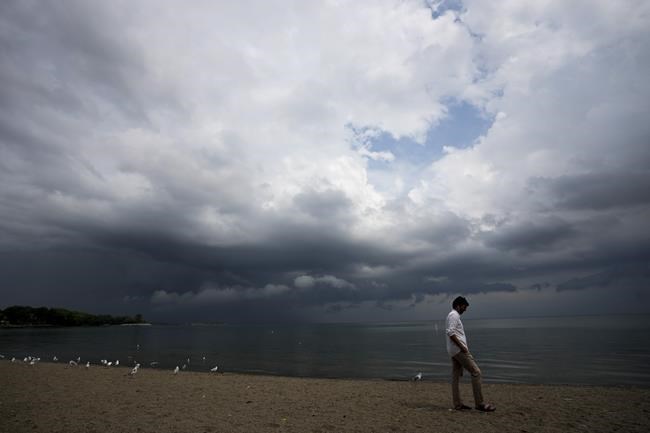If nothing else, 2022 gave Canadians a slew of new weather words.聽
There was "springuary" for the winter that wouldn't leave. There was "hotumn" for the fall that never came.
"Derecho" got new currency after the powerful winds flattened a swath of Ontario. Rain-swamped Montreal gave us "urban flooding."
And east coasters learned just what a "hybrid storm" means from hurricane Fiona -- the top pick of Environment Canada's senior climatologist for top weather story of 2022.
"Fiona was a large-scale, high-impact storm -- likely the most damaging hurricane in Canadian history in terms of insurance costs with initial estimates of $700 million," Dave Phillips said in his 27th annual rundown.
Winds gusted past 100 km/h across five provinces during the September blast. Fiona -- a hybrid of a hurricane and a cyclone -- destroyed houses and wharves, knocked out power to more than 600,000 homes and businesses and reshaped coastal geography, including that of Prince Edward Island's beloved red sand beaches. Three people died. 聽聽
No. 2 -- a group of thunderstorms moving in a line that tore through Ontario and Quebec in May.聽
"I've heard of derechos before, but they were always in the forested areas of Ontario," Phillips said. "This one went along the 401 (highway)."
At least three tornados, with winds upward of 190 km/h, were recorded near Uxbridge, Ottawa and London. Kitchener-Waterloo set a new windspeed record of 132 km/h. Environment Canada broke into radio broadcasts for the first time to announce a weather warning over a thunderstorm.聽
At least 11 people were killed, mostly by falling trees. Insurance claims topped a billion dollars.聽
Manitoba got its turn in the spring. Phillips' No. 3 weather story is the series of drenching snow and rain storms that dropped more than 330 millimetres of precipitation on Winnipeg -- an amount almost four times normal that shattered a 125-year-old record.聽
Flooding was the result. Forty-five municipalities and nine First Nations declared local states of emergency due to washed-out roads, swollen ditches, flooded properties and damage to water treatment infrastructure. Entire towns were surrounded by water. 聽
At one point, Winnipeg released 60 million litres of untreated sewage into the Red River instead of letting it back up into countless basements.聽
City flooding is on the increase, Phillips said.
"River flooding was always Canadian," he said. "But those kinds of urban floods -- street floods -- this is the new flood."
The weather weirdness continued.聽
The summer broke more than 500 maximum daily temperature records, mostly in British Columbia and Alberta. Lytton, 小蓝视频, which set the national all-time high temperature record in 2021, again topped out with a high of 39.6掳C -- an all-time September record for the province.聽
It was dry, too. Vancouver only got 13 millimetres of rain from July to October. That's seven per cent of normal. Communities on 小蓝视频's Sunshine Coast declared local states of emergency and rationed water. 聽
Meanwhile, what's up with the shoulder seasons? For many Canadians, spring and fall got squeezed out between winters and summers that just wouldn't quit.
"We had seasons that lasted a day or two and others that went on for months longer than their normal allotment," said Phillips. "I think spring lasted three days."
And everywhere there were storms.
In June, the southern Prairies got more than a month's worth of rain in three days. In August, central Alberta saw a hailstorm that produced one Brobdingnagian pellet that weighed almost 300 grams, one of the world's largest 25 hailstones.聽
Wiarton, Ont., got 54 centimetres of snow in 10 hours in November. In June, western Quebec had its own baseball-sized hail, accompanied by up to 60 millimetres of rain in three hours.聽
The lesson, if there is one, is that climate change is producing more variable weather in a country already renowned for it, Phillips said.
"This isn't just another year of weird and wacky weather," he said. "There is a connection, a thread, that connects these things together.
"People focus on the extremes of climate change. But it's also the variability, the wild swings."
The average mean temperature in Canada between 1948 and 2016 increased by 1.7 degrees.聽
"What will three degrees of warming be like?" asks Phillips.聽
This report by The Canadian Press was first published Dec. 21, 2022.聽
Bob Weber, The Canadian Press




